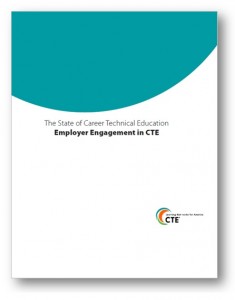 Yesterday, we released a summary of several state of the state addresses, focusing on their implications for CTE in the year ahead. Below is the second installment in this CTE Month special series, highlighting more governors who took time out of their state of the state address to endorse programs for high-quality CTE in their state.
Yesterday, we released a summary of several state of the state addresses, focusing on their implications for CTE in the year ahead. Below is the second installment in this CTE Month special series, highlighting more governors who took time out of their state of the state address to endorse programs for high-quality CTE in their state.
During the State of the State Address in Connecticut, Governor Dannel Malloy embraced “hands-on learning,†committing his administration to working with private-sector partners and educators to provide for early college and dual enrollment initiatives. He also commended the P-Tech program, a collaboration between IBM and a number of New York City high schools that guides students through high school and provides for an additional two years of instruction. Graduating students complete the P-Tech program with advanced credentials and Governor Malloy expressed his desire to emulate this in Connecticut by offering a comprehensive, skill-centered pathway for students to credentials above and beyond a high school diploma.
Georgia Governor Nathan Deal touted the state’s High Demand Career Initiative, designed to bring together leaders of the University System of Georgia, technical colleges and schools, and state industry leaders to understand labor market needs, as well as a $10M loan program for students attending technical colleges.
In Indiana, Governor Mike Pence outlined his desire to make CTE an option for every Hoosier student. He encouraged not only the development of programs to allow secondary students an easier path into postsecondary CTE programs, but also for adult education that would allow professionals to seek retraining to improve their skills and competencies making them more competitive in today’s labor market.
Governor Terry Branstad of Iowa promoted his Iowa Apprenticeship and Job Training Act, entailing a number of initiatives to increase student access to apprenticeships by tripling funding for apprenticeships under the state’s 260F worker training program.  He also cited his state’s recent success expanding STEM education, anticipating 60,000 or more students will have access to STEM programs in the state as a result of the efforts of the STEM Advisory Council, an initiative led by Vermeer CEO Mary Andringa and Lieutenant Governor Kim Reynolds.
Governor Sam Brownback of Kansas touted a 75 percent increase in enrollment in CTE since the state launched its Career Technical Education Initiative. The sweeping plan from 2012 included $8.75 million for CTE programs, covering tuition for students taking postsecondary CTE courses, $1.5 million to high schools that encourage students to earn industry recognized credentials and allotting funds to spread the word about job opportunities for CTE graduates.
In Maryland, Governor Martin O’Malley announced his desire for every high school student in Maryland to graduate with a modern technical skill and a year of college credit already earned.
Governor of New Hampshire Maggie Hassan embraced developing STEM education in the Granite State as a response to the needs of the state’s high-tech industry. Governor Hassan cited restoring previously cut funds to New Hampshire higher education as a strategy to entice business to the state, and indicated that a well-trained and career-ready workforce was key to economic development in the granite state.
In the Oklahoma State of the State Address, Governor Mary Fallin called education beyond high school “the new minimum†for Oklahomans entering the workforce, and expressed her desire to increase the number of graduates seeking qualifications beyond a high school diploma “…either by attending college or a career technology center.†She also cited increasing numbers of Oklahomans seeking degrees or certificates as a result of collaboration with CareerTech in the Complete College America initiative.
In South Dakota, Governor Dennis Daugaard focused heavily on CTE, which he labeled “…the intersection of education and economic development.†In a series of proposals to enhance CTE and draw more students into technical fields the governor advocated for $5 million in Governor’s Grants for CTE to improve collaboration between secondary schools offering CTE courses, along with $3.8 million in Future Fund grants to technical institutes for workplace priority areas and extra funds for scholarships for students in high need fields.  He also touted Building South Dakota, the economic development fund that incorporates infrastructure, housing, and development funds along with CTE funding.
Continuing with his year-old Drive to 55 initiative, (a program to ensuring 55 percent of his state’s citizens possess credentials above a high school diploma by 2022), Governor Bill Haslam of Tennessee voiced his support for expanded CTE and career readiness programs. Adding onto Drive to 55’s expanded dual enrollment, workforce readiness and curriculum alignment initiatives, Governor Haslam announced the “Tennessee Promise†program. Tennessee Promise will provide Tennessee secondary graduates with the opportunity to go to two years of community college or college of applied technology education free of charge. Continuing his push for expanded educational opportunity, Governor Haslam included in his address further funding for college expansion and renovation across the state, including $65 million for expanding two of the largest community colleges in Tennessee.
Evan Williamson, Communications Associate
 with the CTE enterprise to help prepare students for success in careers.
with the CTE enterprise to help prepare students for success in careers.

 activity as it relates to Career Technical Education (CTE). Further explanation of the series can be found
activity as it relates to Career Technical Education (CTE). Further explanation of the series can be found 